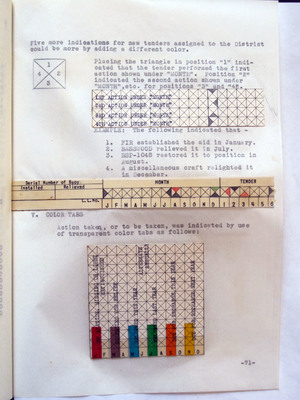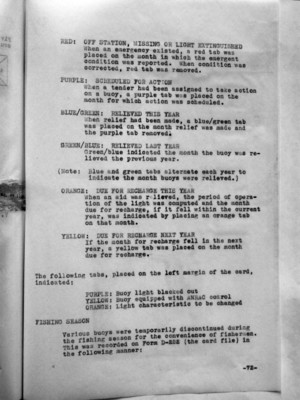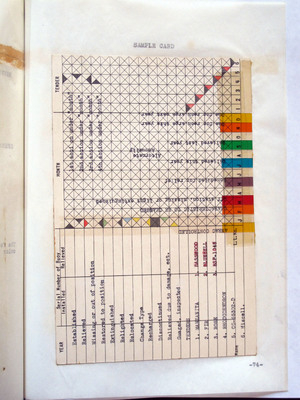Pages
91
Five more indications for new tenders assigned to the district could be more by addinga different color. placing the triangle in position "1" indicated that the tender performed the first action shown under "MONTH". Position "2" indicated the second action shown under "MONTH", etc. for positions "3" and "4".
92
RED: OFF STATION, MISSING OR LIGHT EXTINGUISHED When an emergency existed , a red tab was placed on the month in which the emergent condition was reported. When condition was corrected, red tab was removed.
PURPLE: SCHEDULED FOR ACTION When a tender had been assigned to take action on a buoy, a purple tab was placed on the month for whihc action was scheduled.
BLUE/GREEN: RELIEVED THIS YEAR When relief had been made, a blue/green tab was placed on the month relief was made and the purple tab removed.
GREEN/BLUE: RELIEVED LAST YEAR Green/blue indicated the month the buoy was relieved and previous year. (Note: Blue and green tabs alternate each year to indicate the month buoys were relieved.)
ORANGE: DUE FOR RECHARGE THIS YEAR When an aid was relieved, the period of operation of the light was computed and the month due for recharge, if it fell within the current year, was indicated by placing an orange tab on that month.
YELLOW: DUE FOR RECHARGE NEXT YEAR If the month for recharge fell in the next year, a yellow tab was placed on hte month due for recharge.
The following tabs, placed on the left margin of the card, indicated: PURPLE: Buoy light blacked out YELLOW: Buoy equipped with ANRAC cotrol ORANGE: Light characteristc to be changed
FISHING SEASON Various buoys were temporarily discontinued during the fishing season for the convenience of fishermen. This was recorded on Form D-222 (the card file) in the following manner:
93
REVERSE SIDE
On the reverse was typed the following information: 1. Name of buoy 2. Light List or Page Number of buoy 3. Authority for establishment 4. Authorized equipment 5. Characteristics 6. Remarks
OPERATION In order to keep the record current, the following reports were checked against it: 1. Buoy Report 2. Approved Form 2609 3. Battery Installation Report 4. Accumulator Installation Report 5. Completed Tender Order 6. Completed Work Request 7. Inspection Report 8. Other reliable sources
The following page is a guide card for marking and placing color tabs on the buoy cards.
95
TENDERS
In order to keep the navigational aids in proper working condition, a fleet of tenders was necessary to service buoys and lights throughout the waterways of the nation. With the first Congressional appropriation for buoys for the Northwest, a tender, the SHUBRICK, a wooden hulled, side wheeler, was assigned to the Pacific Coast. The SHUBRICK, as well as other early tenders, served double duty, acting as both buoy tender and revenue outter. In her latter capacity, the SHUBRICK carried 12-pound cannons as well as small arms. This single vessel serviced all aids along the coast until February, 1880, when the vessel was transferred to the lower Pacific Coast and relieved in the Seattle area by the first MANZANITA. Of historical interest is the fact that the SHUBRICK was the first vessel of considerable size to navigate the Columbia River beyond the present location of the Bonneville Dam.
As traffic in the Northwest waters increased, so did the need for navigational aids and, consequently, the work of the tenders. The first MANZANITA carried the burden along until the COLUMBINE, a U.S. Army Engineers vessel, was assigned to the same area. This ship was built and maintained by the U.S. Army Engineers and operated by the Lighthouse Service for servicing aids of the Lighthouse Establishment. ( As the Bureau of Lighthouses was previously called.) The MANZANITA was sunk off Warrior Rock in the vicinity of St. Helens, Oregon, in the Columbia River, and the COLUMBINE performed tender duties alone until the second MANZANITA was completed. These two, together with the HEATHER, operated for several years until the COLUMBINE was transferred to the Honolulu District. The ROSE, and soon thereafter, the RHODODENDRON and FIR were commissioned and assigned to duty in the Seattle Area. When the FIR reported, the HEATHER was removed from duty and tied to the sea wall at the Lake Union Locks until the outbreak of the war. At that time, the Army borrowed her and she was never returned. The old MANZANITA lay for a considerable time a derelict, off Warrior Rock, but was raised, refitted and is still operating as a seagoing tug under the name DANIEL KERN. Two fine tenders were commissioned and attached to the 13th Naval District during the war, the BASSWOOD, 1944, and the BLUEBELL, the following year. The BASSWOOD was transferred after a year's general aids to navigation duty which involved servicing isolated units and the LORAN project in Vancouver Island. ( See LORAN). In addition to these large tenders, the CG-65302-D was engaged in buoy work and the maintenance of minor aids on the Upper Columbia River between the Dalles, Oregon and Pasco, Washington.




